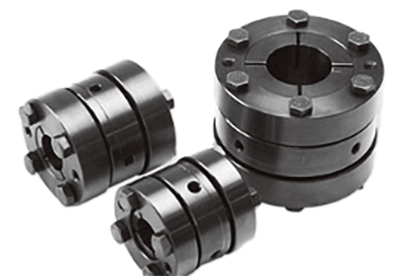What Is a Rigid Coupling?

A rigid coupling is a mechanical component designed to connect two shafts and transmit rotational motion. Unlike other couplings, it is made entirely of rigid materials like metal, without any rubber, resin, or sliding parts. This design means that rigid couplings do not accommodate misalignment between shafts or absorb vibrations, but they are capable of transmitting large amounts of torque and have no backlash due to the rigid connection.
Another advantage of rigid couplings is their simplicity and cost-effectiveness, as they have fewer components than other coupling types.
Applications of Rigid Couplings
Rigid couplings, being purely rigid, offer high torsional rigidity and a smaller diameter than other couplings, reducing the moment of inertia. This makes them ideal for precise position control with servomotors or stepping motors, where zero backlash is crucial.
They are also a cost-effective solution in situations where misalignment or vibration is not a concern. Common applications include:
1. Coupling of Machine Tool Motors and Spindles
Used in machine tools where high torque and torsional rigidity are necessary to suppress vibration, rigid couplings facilitate alignment and efficient torque transmission.
2. Connection of Long Shafts
When long shafts, originally manufactured as a single piece, need to be cut for machining, assembly, or transport, rigid couplings can reconnect them, maintaining the precision and robustness of the original shaft.
3. Rotary Angle Measuring Devices (Encoder)
Rigid couplings are crucial in devices like encoders where minimizing shaft torsion and backlash is essential for accurate angle measurement.
Principle of Rigid Coupling
Rigid couplings consist of a coupling body, typically made from aluminum alloy, steel, or stainless steel, and a part for fastening to the shaft. Their structure ensures zero backlash in a rotational direction, making them suitable for high-precision control applications.
However, due to the lack of misalignment tolerance, precise alignment of shaft centers is crucial during installation. Misaligned shaft centers or large rotational runouts can lead to assembly difficulties or damage due to vibration or excessive force on the shaft support.
For applications requiring shaft center misalignment accommodation, Oldham, cross-joint, or disk-type couplings are used.
Types of Rigid Couplings
Rigid couplings are classified based on their shaft fixing method:
1. Screw Fixing Method
This method involves securing the shaft with a set screw, sometimes combined with a keyway.
2. Clamping Method (Slit Method)
A slit in the coupling allows a clamping bolt to tighten and press the shaft against the coupling.
3. Split Method
The coupling is split radially into two parts, fixed and fastened to the shaft from both sides for a robust connection.
4. Friction Method
Using a wedge (taper), nuts are tightened on both ends to secure the shaft. The nuts have opposite thread directions to prevent loosening from shaft rotation. The coupling’s mounting direction depends on the shaft rotation direction.